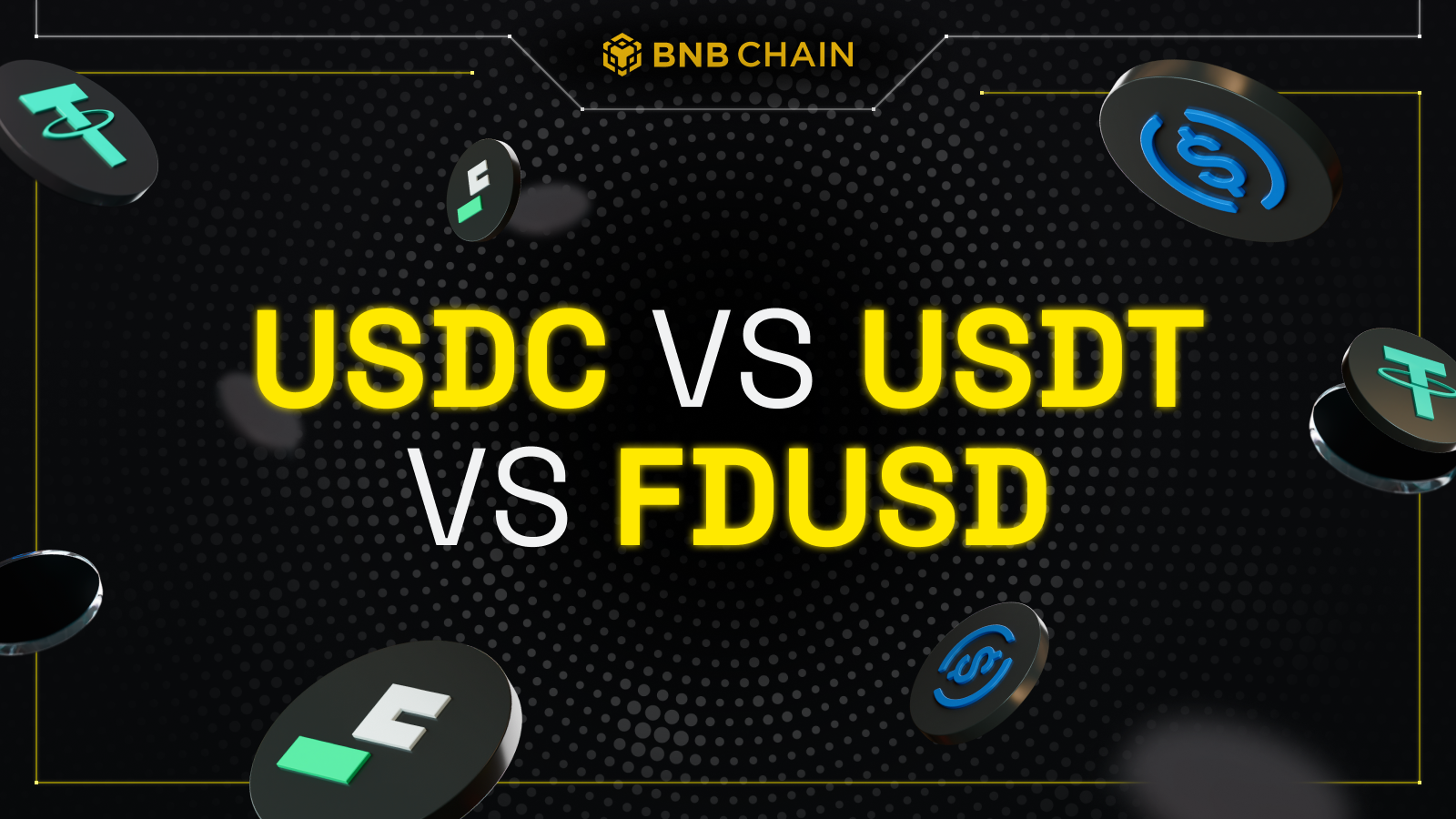Table of Contents

Stablecoins, as their name suggests, help stabilize the crypto markets by providing a less volatile alternative to popular cryptocurrencies, making them more suitable for everyday transactions. This article will explore three widely-used stablecoins—USDT, USDC, and FDUSD—and compare their features. We’ll also dive into how stablecoins function and why BNB Chain is an ideal platform for their use.
What Are Stablecoins?
A stablecoin is a cryptocurrency with a value pegged to another asset or commodity, such as fiat currency or gold. Stablecoins play a vital role in the larger cryptocurrency ecosystem, offering stability in a market known for its volatility.
Traditional cryptocurrencies like Bitcoin (BTC) and Ethereum (ETH) are prone to dramatic price fluctuations. Stablecoins maintain a consistent value by pegging their worth to stable assets. Thanks to their price stability, they are highly practical for everyday use, facilitating smoother transactions, and acting as a reliable store of value.
Stablecoins have several use cases, some of which are listed below.
- They have become increasingly popular in trading and DeFi, providing a stable base for trading pairs and yield-generating activities.
- Stablecoins offer an easier way for new traders to explore digital assets and engage with the markets.
- They act as a bridge between the crypto markets and traditional finance, making it easy for individuals and businesses to adopt digital currencies.
- They also enhance the efficiency of payments and remittances by offering instant, low-cost transfers.
USDT vs. UDSC vs. FDUSD: A Stablecoin Comparison
Let’s take a closer look at USDT, USDC, and FDUSD.
USDT
USDT is the world’s largest stablecoin, with a current market cap of $119,701,720,674 and a daily trading volume of $53,294,759,929. It was launched in 2014 by Tether Limited and originally started out as Realcoin before its rebranding in 2015.
As of 2024, USDT is the world’s third-largest cryptocurrency, behind only Bitcoin and Ethereum. While USDT is pegged to the US Dollar, Tether also issues tokens pegged to the Euro, the Chinese yuan, the Mexican peso, and gold.
Tether guarantees that USDT’s value remains pegged to the US dollar by allocating an equal amount of USD to its reserves whenever new USDT tokens are allocated. This makes it an ideal choice for investors during times of intense volatility, as it allows them to safely park their assets without cashing out.
Tether issues regular updates about its reserve holdings. As of March 2024, the company reported assets worth almost $100 billion to back the USDT stablecoin. Tether reported that it held 84.58% of its reserves in cash, cash equivalents, short-term deposits, and commercial paper. Out of this, 76% was in US Treasury Bills. Tether also held 0.05% of its reserves in corporate bonds, 3.62% in precious metals, 2.91% in BTC, 4.95% in secured loans, and 3.89% in other investments.
Despite its dominance in the stablecoin market, USDT has been at the center of several controversies regarding its reserves. This has led to its value occasionally dipping below $1, leading some to speculate that Tether’s dollar reserves may not be fully backed. Additionally, it has also had several ruins with regulatory authorities.
USDC
USD Coin (USDC) was launched in September 2018 and is a fiat-collateralized stablecoin, with its value pegged to the US Dollar. It is the 6th-largest cryptocurrency globally and the second-largest stablecoin behind USDT, with a current market capitalization of $35,509,153,571. USDC was founded by Center, a consortium founded by Circle, along with cryptocurrency exchange Coinbase and Bitcoin mining company Bitmain.
Circle, USDC’s parent company, states that each USDC is backed by a dollar held in reserve, along with other approved investments, and had enlisted the services of accounting firm Grant Thornton to verify the funds. In 2021, Circle changed the wording on its website, removing the “backed by US dollars” to “backed by fully reserved assets.” As of 2023, USDC provides monthly attestation reports reviewed by Deloitte & Touche LLP.
In 2023, USDC lost its dollar peg, falling as low as 87 cents because over $3 billion of its reserve assets were held at the failed Silicon Valley Bank. When the bank collapsed, USDC holders redeemed over $1 billion USDC for dollars, creating a dramatic price slippage.
FDUSD
FDUSD is one of the newest stablecoins in the market. It is issued by FD121 Limited, a subsidiary of Hong Kong-based First Digital Limited. It was introduced in June 2023, with each stablecoin backed by one US dollar or an asset of equivalent value held by First Digital Trust Limited.
As its custodian, First Digital Trust Limited is mandated to keep FDUSD reserves in segregated accounts to prevent commingling with other assets. The reserves must also be held in cash or highly liquid assets.
At launch, the FDUSD stablecoin was issued on the Ethereum and BNB Chains, and it plans to be issued on other blockchains as well. The stablecoin intends to stand out from the competition by offering additional instruments for diversification. FDUSD can be used in remittances, payment solutions, a hedge against volatility, and DeFi applications.
Similarities And Differences Between USDT, USDC, And FDUSD
Despite being issued by separate entities, USDT, USDC, and FDUSD have several similarities. First, all three stablecoins are fiat-backed and are pegged to the US dollar in a 1:1 ratio. Almost all major exchanges also accept USDT and USDC, available on several blockchains. However, FDUSD, a newer stablecoin, is only available on the Ethereum blockchain and BNB Chain. All three stablecoins are regularly audited to ensure greater trust and transparency.
| USDT | USDC | FDUSD | |
| Year Of Issue | Launched in 2014 | Launched in 2018 | Launched in 2023 |
| Parent Entity | Tether | Circle | First Digital Limited |
| Blockchain Networks | Ethereum, Avalanche, Algorand, Polygon, Solana | Ethereum, Solana, Polygon, Stellar, Algorand | BNB Chain, Ethereum |
| Reserves | Cash and cash equivalents, US Treasuries, Commercial paper, Crypto assets, Corporate bonds, Secured loans | Cash and US Treasuries | US Dollar or asset of equivalent value held by the appointed custodian |
| Market Capitalization | ~$120B | $35,5B | $2.7B |
BNB Chain: The Ideal Platform For Stablecoins
There are several reasons why BNB Chain is considered an ideal platform for stablecoins.
- The BNB Smart Chain and its Layer 2 solution, opBNB, have over a million daily active users, making them the market’s most used Layer1 and Layer2 chains.
- BNB Chain and OpBNB also offer outstanding transaction capability. BNB Chain can handle a significant surge in demand without impacting gas fees thanks to a recent expansion of its gas limit to 140 million. OpBNB has also significantly increased its gas limit to 200 million and enabled over 10,000 transactions per second.
- BNB Chain’s highly developed ecosystem has thriving Web3 gaming, DeFi, and memecoin communities. These communities give stablecoin holders maximum engagement and utility.
- Gas fees on the BNB Chain are lower than $0.01, while those on opBNB are even lower, at around $0.001. This makes both chains highly cost-effective.
BNB Chain has integrated and incentivized stablecoins within its ecosystem through several initiatives, such as:
- Gas-Free Carnival
- DeFi integration
- TVL incentive growth
For more details on each, check our previous blog.
BNB Chain has also partnered with payment gateways to enable real-world transactions using stablecoins. These partnerships bridge the gap between digital and traditional financial systems and make stablecoins a practical choice for everyday transactions. BNB Chain-powered stablecoin payments are available on Alchemy Pay, Oobit, Lunu, MugglePay, and Now Payment.
In Closing
Stablecoins have assumed a vital role in the crypto ecosystem, providing the speed and security features of blockchains without the volatility. Thanks to their low volatility, stablecoins have become quite popular among traders and have also found use in everyday transactions.
BNB Chain’s efforts to promote stablecoin adoption highlight its commitment to making cryptocurrencies easily accessible. This helps simplify access to DeFi and encourages more users to explore its benefits. All of these efforts are aligned with BNB Chain’s goal of onboarding the next billion users to Web3.

